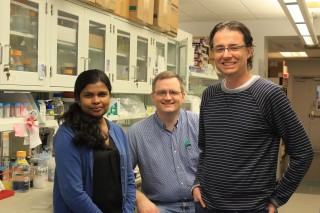UK Researchers Solve Metabolic Mystery Lending Insight Into Lafora Disease

UKNow From left: Madushi Raththagala, Craig Vander Kooi and Matthew Gentry.
Matthew Gentry, Ph.D, and Craig Vander Kooi, Ph.D, associate professors of molecular and cellular biochemistry, and researcher Madushi Raththagala, Ph.D, recently discovered the role of the enzyme laforin in modifying human glycogen and thereby preventing neurodegeneration.
Their work provides fundamental insights that link energy metabolism with the fatal, neurodegenerative form of epilepsy called Lafora disease. These findings were reported Jan. 22, 2015, in the journal, Molecular Cell.
Lafora disease was first described by Gonzalo Rodriquez-Lafora in 1911. In 1998, a team of scientists at University of Toronto identified the laforin gene as being mutated in Lafora disease patients. Mutations in the gene encoding the laforin protein result in the accumulation aberrant glycogen-like accumulations called Lafora bodies that resemble plant starch more than human glycogen.
Previous research showed Lafora bodies are the driving agents of Lafora disease. Lafora disease patients develop normally until their second decade of life when they experience an epileptic episode. These episodes increase in severity and number until the patient eventually dies from a massive seizure, status epilepticus or aspiration pneumonia.
Through their research, Raththagala, Vander Kooi, and Gentry determined the structural basis for the specific enzymatic function of laforin. This discovery allowed them to define how laforin modifies glycogen to inhibit Lafora body formation. Additionally, their work defines why specific patient mutations in laforin result in the disease, which opens pathways to understanding and treating the disease.
“A number of groups have tried to determine the structure of laforin over the last 17 years and no one had succeeded,” Gentry said. “Dr. Raththagala worked tirelessly trying different strategies that we developed to achieve this goal. When we realized our success to get over the final hurdle, I had to sit down to fully comprehend our accomplishment. It is exciting to report this structure, but even more exciting to now consider potential therapeutic possibilities.”
MEDIA CONTACT: Elizabeth Adams, elizabethadams@uky.edu
Media Contact
More Information:
http://www.uky.eduAll latest news from the category: Health and Medicine
This subject area encompasses research and studies in the field of human medicine.
Among the wide-ranging list of topics covered here are anesthesiology, anatomy, surgery, human genetics, hygiene and environmental medicine, internal medicine, neurology, pharmacology, physiology, urology and dental medicine.
Newest articles

NASA: Mystery of life’s handedness deepens
The mystery of why life uses molecules with specific orientations has deepened with a NASA-funded discovery that RNA — a key molecule thought to have potentially held the instructions for…

What are the effects of historic lithium mining on water quality?
Study reveals low levels of common contaminants but high levels of other elements in waters associated with an abandoned lithium mine. Lithium ore and mining waste from a historic lithium…

Quantum-inspired design boosts efficiency of heat-to-electricity conversion
Rice engineers take unconventional route to improving thermophotovoltaic systems. Researchers at Rice University have found a new way to improve a key element of thermophotovoltaic (TPV) systems, which convert heat…



